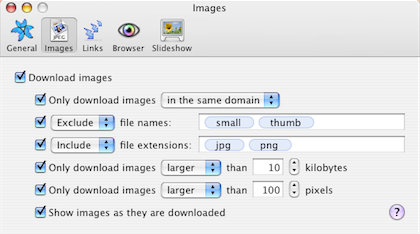Software Review
HyperImage 1.0

Developer: KavaSoft
Price: $30
Requirements: Mac OS X 10.4. Universal.
Trial: Feature-limited (adds a watermark to downloaded images)
HyperImage downloads pictures posted and linked throughout a Web site’s structure and presents them for slideshow or directory viewing. As a reviewer of music and software, this helps me find specific screenshots, concert pictures, and so on. Rather than pick through Google’s image search one-by-one, I can build an expansive review of pictures available away from the Web. An application that can take a series of site URLs, download them over lunch, and present the contents at my leisure definitely wins over the time and mental effort of clicky-clicky-click.
Installation
It doesn’t take much to get HyperImage going. Download the DMG, mount it, and drag it into your Applications folder.
Feature Exploration
Enter a Web site’s URL in the address bar and choose Download to start the cascade of data to your Mac. The pictures (and directory structure) from a site appear below the address bar as they arrive.

The download and browsing layout.
If you’re looking at sites with a wide-ranging goal, like my interest in a good concert picture, the default options capture just about everything for picking and choosing. If too much dross gets through, the preferences pane helps you cut down the total number returned.

Limiting images by domain, type, and size.
I found this most useful to eliminate thumbnails and other small pictures, since they don’t look good posted with an article. Other users, especially those on dial-up, might prefer only pictures below a certain size to reduce download time.
Slideshows work much like iPhoto or other image presentation software. You can look at a big platter of images within a window or toggle the full-screen viewer to absorb the whole screen.

The full-screen viewer works both during and after image downloads.
Some sites number their images sequentially, like 001.jpg, 002.jpg, and so on. Target one of these specific groups by enclosing the desired image range in brackets as part of your URL.
While HyperImage does include features like a site “mirror” that downloads everything or checks the pages for broken links, it rightly focuses on image capture and presentation. (The link-checker, for example, probably matters most to image-site Web masters, and they should already have one of those.)
Most Useful Feature
HyperImage targets image collection so directly, it’s hard to pick out a single “best” element. I guess the fact that everything runs in the background and you can queue up several sites for sequential download serves as my favorite feature.
Bugs and Nitpicks
After using HyperImage on-and-off for a few weeks, my usage patterns changed. Instead of entering one URL and watching the images arrive, I let everything finish prior to review. If I changed my mind partway through, it took quite a while for the “stop downloading” command to take effect. To avoid that irritation, I’d just wait for the download to finish, browse a few results, set new “filters” for the site that eliminated a category of useless images, and run everything again. The application would be more efficient (and feel more like a Web browser) with a very responsive “stop” button.
I only ran into one stability problem using HyperImage. While working on a music review, I checked out the ThomasDolby.com site for suitable artist pictures. Unfortunately, something about the site caused the application to crash and close. I re-opened it and tried again with the same result. I rebooted my Mac and tried again with the same result. This proved the only crash-causing site I found during my month-long review usage. (Of course, actually trying to break the program might have found more issues.)
Is It Worth the Money?
I definitely see the value in HyperImage, given the amount of time you can spend clicking around (and around) on image sites. Almost every URL I “visited” provided a nice list of pictures that tell the site’s story without all that bothersome text. For version 1.0 software, it follows through well on delivering a complete site’s images. If a software update corrected my issues with the interaction delay and crash-causing sites, the whole package would be even more useful.
Summary
People who like to work with big caches of images should get a lot of utility out of HyperImage. At first glance, it looked like a cousin to Google’s image search, but with more comprehensive results. After some use, it seems the two really go hand-in-hand. Search first for image sites that match a desired term (say, “lolcats”) and then let HyperImage plumb the depths of the URLs you find.
Reader Comments (1)
Add A Comment